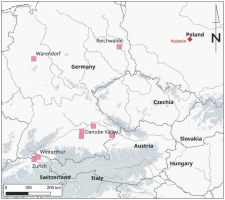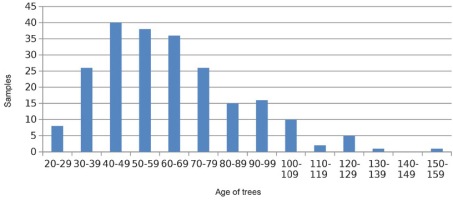. Introduction
Terrestrial proxy records, in particular those of high resolution, are especially important in studies of extreme climatic changes that occurred at the end of the Last Glacial. Annual tree-ring measurements are best suited for obtaining the high-resolution temporal data, but Late-Glacial wood suitable for dendrochronological analysis is spare (Hua et al., 2009; Kaiser et al., 2012; Hogg et al., 2013; Griggs et al., 2017; and Dzieduszyńska et al., 2014a). In Europe, the sites with subfossil wood from the end of the Late Glacial have been identified mostly in the area of the Alps and its surroundings (Kaiser et al., 2012). The most important sites with Late-Glacial wood are as follows:
Reppisch and Sihl river valleys near Zurich as well as Dättnau river valley situated east of Winterthur (Switzerland) – the Late-Glacial chronology (SWILM) spanning more than 1600 years (14300–12700 cal BP) was constructed on the basis of wood fragments found there (Kaiser et al., 2012).
The Uetliberg in Zurich – the study of more than 250 subfossil trunks allowed to construct eight chronologies spanning more than 2000 years in total, dated to Allerød and YD (Reinig et al., 2018).
Gravel pits in valleys of the Danube River and its tributaries Günz and Isar (southern Germany) – tree trunks buried in their alluvia were redeposited; therefore, they cannot be a basis for conclusionson the Late-Glacial tree communities in this area, but chronologies based on their analysis are very accurately correlated with other chronologies of this period from northern Germany and Switzerland (Spurk et al., 1998; Friedrich et al., 2004; and Kaiser et al., 2012).
Reichwalde in eastern Germany – 584-year-long chronology started at the beginning of the Allerød (Friedrich et al., 2001).
Warendorf in northern Germany – 466-year-long chronology from the middle Allerød (Kaiser et al., 2012).
Durance river basin in the Southern Alps, France – alluvial materials were deposited there since the Allerød up to the Atlantic Phase (14500–7000 cal BP); trees found there had vegetation dynamics very similar to trees excavated from the same period in Switzerland; however, the chronologies have not been correlated yet (Miramont et al., 2000).
Quarry next to the Revine lake (Treviso, Italy) – remnants of a larch community from a period of 15200–14300 cal BP (14C) (Corona, 1984 and Friedrich et al., 1999),
Alluvial sediments of the Dora Riparia River near Avigliana, north of Torino (Italy) – 253-year-long chronology dated to Boelling (Kaiser et al., 2012).
Gravel pits in the Po river valley, south of Torino – 344-year-long chronology dated to 14500–14150 cal BP (Boelling) (Kaiser et al., 2012).
Palughetto peatland in the Cansiglio Plateau (Italy) – tree trunks from the Boelling and Allerød transitions (Vescovi et al., 2007).
Moreover, in the Koło Basin (central Poland), a continuous horizon of organic sediments with subfossil tree trunks has been discovered and studied in pit faces of the JSC Lignite Mine at Koźmin Las site (Petra, 2002; Petera-Zganiacz, 2007). Organic deposits (mostly peat and organic mud) bearing trees occurred within the Late Weichselian low-river terrace. The subfossil tree trunks were found at the top of a peat series of variable thickness. The peat series is underlain by a sand series of a thickness varying from 2 m up to ca. 10 m and overlain by several tens of centimetres thick gyttja or rhythmically layered organic mud and sand without organic admixture. First radiocarbon dates of the bottom of the organic series were as follows: 10870±170 BP and 10830±170 BP (Petera– Zganiacz, 2007), while dating of the subfossil wood indicated its Allerød and Younger Dryas ages (Kittel et al., 2012 and Dzieduszyńska et al., 2012, 2014a). The organic horizon bearing tree trunks at the Koźmin Las site was subsequently a subject of detailed multiproxy, interdisciplinary studies (Dzieduszyńska and Petera-Zganiacz, 2012; Kittel et al., 2012; and Dzieduszyńska et al., 2012, 2014a, 2014b).
. Koźmin Las site
The Koźmin Las site is located in the territory of the village of Koźmin (52o 04’51”N, 18o40’3” E, 97.5 m a. s. l.) (Fig. 1). In 2010–2011, a research trench 20 m long and 6 m wide was excavated there. Within it, after removing 1.8-m-thick caprock of overbank deposits (Kittel et al., 2012; Dzieduszyńska et al., 2012, 2014a; Petera-Zganiacz et al., 2015; and Kittel, 2015), excavation was done using an archaeological approach, by removing individual successive 5- to 10-cm-thick layers and recording the situation of each of the wood fragments (Kittel et al., 2012 and Dzieduszyńska et al., 2014a). More than 300 wood remains, i.e. trunks, branches, roots and other wood fragments, were sampled. Most of the roots documented at the site represented in situ positions.
On the basis of performed analyses of sediments, the Koźmin Las sequence was divided into three sections: lower – sandy, middle – organic, composed of peat, gyttja and organic mud bearing wood remains, and upper – sandy– silty one (Petera-Zganiacz et al., 2015 and Kittel, 2015). Root system of the majority of fossil trunks extended in organic sediments of the middle section and underlying sands. The trees grew relatively close to each other (2–4 m). Part of the trees fell during their growth – this is evidenced by remained bark and bending of the stumps in their lower parts, as well as positions of roots indicating a tree uprooting. Traces of fluvial transport discernible on some trunks situated within the upper, fluvial section indicate their redeposition (Dzieduszyńska et al., 2012, 2014a).
Interdisciplinary, multiproxy research performed at the Koźmin Las site included geological and geomorphological descriptions, spatial analysis, dendrological and dendrochronological studies, palynological analysis, plant macrofossil analysis, Cladocera analysis, Chironomidae analysis, geochemical analysis of the sediments, and radiocarbon dating of numerous samples of wood and plant macrofossils and organic sediments (Dzieduszyńska et al., 2014a and Kittel et al., 2012).On the basis of results of these studies, the following sequence of palaeoecological changes in this area can be reconstructed: the first stage of the deposition occurred within a very shallow, periodically overflowed valley; after the desiccation of sediments, a soil horizon formed at the valley bottom (this process developed between 12700 and 12600 cal BP); subsequently, a peat and forest plant succession occurred (a period of the most vigorous tree vegetation in this place is dated to 13000/12900–12700/12600 cal BP). Finally, evidence of succeeding shallow water basin with reduced discharge (12700/12600 cal BP), and later accelerated flooding activity, which definitely closed the peat accumulation (ca. 12600–12100 cal BP), is observed there (Dzieduszyńska et al., 2014a).
In 2011, from the research trench, 114 wood samples, each comprising more than 25 tree rings, were taken for the dendrochronological analysis. On the basis of the most convergent sequences, a chronology spanning 133 years was constructed. A significant majority (N=57) of studied wood fragments originated from young trees, 50 to 60 years old. Apart from short sequences, the occurrence of zones with narrow tree-rings and anomalies such as missing rings were the factors hindering the correlation (Dzieduszyńska et al., 2014a). This was the reason why a new sampling campaign to collect more wood took place.
. Materials and methods
Field collection
In 2014, within the framework of the NSC project no. 2013/09/B/ST10/02249, a series of organic sediments bearing subfossil trees was outcropped next to the research trench made in 2010–2011. The new trench, situated northeast of the previous one (Fig. 2), was 24 m long and 6 m wide. A caprock layer was mechanically removed by the bulldozer, whereas the excavation of the organic series was performed using an archaeological approach: around 10-cm-thick levelling layers were manually removed. The successively excavated situations were documented by photography, and photogrammetry; orientation, dimensions and mutual relations of wood fragments were recorded.
Fig 2
Distribution of subfossil wood in the research excavations at the site Koźmin (the 2011 excavations in the lower part, the 2014 excavations in the upper one).
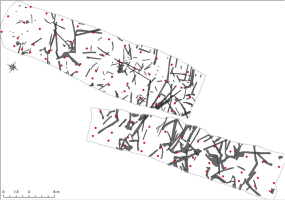
Within the trench, more than 160 well-preserved wood fragments were registered. The fallen trees were characterised by small diameter up to ca. 20 cm and a length up to 3.5 m. Within the organic series, pine trees with barks were recorded as well. Moreover, in situ roots comprising plate-like systems and developed both within the organic series and in the underlying sands were observed. A fraction of the trunks was specifically hooked in their lower parts. In the sediments above the organic series, partly deformed split fragments of probably redeposited trunks occurred.
The zones without deformations of annual tree rings (caused by branches or others) of larger fragments of sub-fossil wood were sampled in a form of trunk slices 15–25 cm thick. The smaller wood fragments were sampled for anatomic analysis. All samples were numbered and wrapped in plastic bags. Other remnants of the subfossil trunks with other organic and inorganic materials were left in situ and reburied.
. Laboratory methods
Wood samples were cleaned, any retained sediments were noted, and tree species were identified from macro- and microfeatures on the transverse, radial and tangential surfaces in comparison with what was reported in the main reference texts regarding wood anatomy (Godet, 2008, Schweingruber, 1990). Prior to the measurements, two to four measurement paths, typically 2–3 cm wide, were made with a dissecting knife on each of the samples along the radii. Samples prepared in this manner were then subjected to measurement of the width of annual rings with an accuracy of 0.01 mm using the Dendrolab 1.0 apparatus for dendrochronological measurements (Zielski and Krąpiec, 2004). The TREE-RINGS computer software (Krawczyk and Krąpiec, 1995), as well as the TSAP software (Rinn, 2005), was used to process the measured tree-ring sequences.
All cross-correlations between samples were validated by statistical tests, including t-coefficient (Baillie and-Pilcher, 1973), and the percentage of year-to-year increase or decrease in ring widths of both samples in their overlap, a “Gl coefficient” (Gleichlaeufigkeit; Eckstein and Bauch, 1969). Finally, as an ultimate test for acceptance of cross-correlations, the visual evaluation of similarity between logarithmically transformed raw curves was employed.
In the next stage, the accuracy of the measurements and the quality of the cross-dating were checked by means of the COFECHA program (Holmes, 1983). This program enables the efficient identification of missing rings and measurement errors. Cross-dated sequences were combined into a multisample chronology and further validated by the inter-correlation of the samples. The standardised chronologies were produced using the ARSTAN_4.1d program (Cook and Krusic, 2005). Chronologies were compiled based on the best correlated individual sequences using the TSAP software.
The samples of selected annual tree rings were washed in distilled water, and α-cellulose was extracted using a method described by Green, 1963. To expedite the separation of single cellulose fibres from wood samples, and thus to increase the penetration of reagents, an ultrasonic bath was used (Pazdur et al., 2005). About 4 mg of α-cellulose extracted from each sample was transferred into a prebaked (900°C) quartz ampoules together with CuO and Ag, evacuated to a pressure of 10−5 mbar, sealed and combusted for 4 h at 900°C in a muffle oven. The resulting CO2 was released under vacuum and cryogenically purified for subsequent graphitisation during the reaction with H2 at 600°C on an Fe catalyst (Nadeau et al., 1998). The mixture of graphite and Fe powder was pressed into a target holder and measured with the AMS system at the Leibniz-Laboratory of the University of Kiel (Labcode KIA, Nadeau et al., 1998). The samples of organic sediments were dated also using the AMS technique in the Radiocarbon Laboratory in Poznań (Labcode Poz, see Goslar et al., 2004 for details).
Since the age of wood relatively dated with the dendrochronological method had to be determined independently, the wiggle-matching method was applied. The method of fitting curves allows for age determination of the chronology with a precision considerably higher than individual 14C dates (Pearson, 1986). Mathematical assumptions of wiggle-matching technique are described by Bronk Ramsey et al., (2001).
For radiocarbon dating, 13 samples were taken. Six of them with the recorded position in the site master chronology were employed for radiocarbon dates used in the wiggle-matching model (D_Sequence). The number of tree-rings within wood segments dated by radiocarbon varied from three to eight (Table 1, see Nos. 1-6). Gaps were set as years elapsed since the central year of one segment to the central year of the next segment. In case of even number of rings, the one selected represented the part of the sequence with wider annual increments. For computing of posterior probability of the first year (year 1) and the last year of the floating site master, Date() command was used (Bronk Ramsey, 2009). In this work, wiggle-matching analysis was performed with the program OxCal 4.3.2 (Bronk Ramsey, 2017) and the calibration curve IntCal13 (Reimer et al., 2013).
Table 1
The list of radiocarbon dates for samples of pine wood from Koźmin site (no. 1-6 – samples used for wiggle-matching; e – external annual growth, the youngest one).
. Results and discussion
The exploration of the Weichselian organic sediments in Koźmin resulted in the discovery of over 500 pieces of sub-fossil wood. A great majority of them represented Scots pine (Pinus sylvestris L.), scarce pieces represented beech (Betula sp.). Altogether 224 samples of pine were qualified for the dendrochronological studies. Selection criteria were based on the state of preservation of wood and the number of tree rings. The dendrochronological analysis was made only for such samples, which fulfilled the criteria of the method, i.e. displayed visible and undisturbed increments, allowing for measurements of their widths, and consisted of a sufficient number of the tree rings – in this study, this threshold is low, 25 years, because of low average individual age of the trees analysed. There were 114 such samples from the trench opened in 2011 and 110 new ones collected in the second trench in 2014.
Whenever possible, approximate ages of trees, with several-year accuracy, were estimated from this material. Majority of the analysed trees were 40–70 years old (n=114), individuals older than 100 years were sporadic (n=19), and only one tree was older than 150 years (Fig. 3). The average age of trees is 65 years.
Most of the trees were characterised by narrow-ring wood with mean ring width below 1 mm. About 30% of trees had slightly wider rings (more than 1 mm), while in a few cases, the average ring width was 2 mm and more (Fig. 4). Relatively wide rings were observed at ca. 30-year-old trees, as well as a few trees aged 40–90 years (Fig. 5). The latter most likely represent redeposited trunks of the trees, which grew in climatically more favourable conditions.
Fig 5
Average growth rate (AGR) in mm/year of the Koźmin trees plotted against their segment length (SL) in number of years.
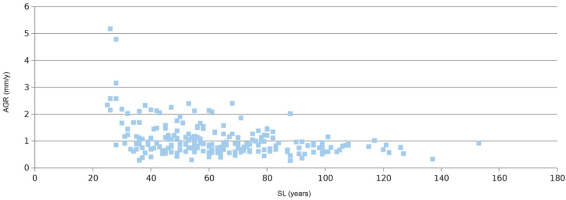
The largest group of samples were transversal slices of trunks, cut from more than 100 pine trees. Exhibiting relatively less growth anomalies, they were used for building the site chronology 2KOZ_A1, which was finally produced from 28 best cross-correlated samples, containing from 50 to 122 annual increments (Fig. 6, supplementary material). This 210-year-long mean curve is based on cross-correlations with average t-value 4.6 and Gl. coefficient 67.5% (P<0.01), sample inter-correlation being 0.473.
Fig 6
The Koźmin Las chronology; individual. tree-ring sequences in grey, average curve in red. Signature years are marked with dots.
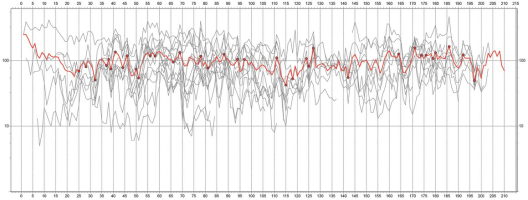
Due to the absence of long reference chronologies for Poland and lack of any satisfactory similarity between the Koźmin site chronology and masters from Germany and Alpine regions, the absolute dating of the floating chronology built in this project (2KOZ_A1) was done by the radiocarbon wiggle matching. Tree rings extracted for radiocarbon dating, their position in the Koźmin site chronology, conventional radiocarbon ages and vague-prior-calibrated 14C dates are presented in Table 1 (nos. 1–6).
The fitting of 2KOZ_A1 site chronology to IntCal13 calibration curve was performed by six radiocarbon determinations in D_Sequence (Table 1, nos. 1–6; Fig. 7). One date (KlA-49440) with individual agreement index (A=21%) below the threshold (60%) does not seem to agree with the model. However, the combination agreement index of this D_Sequence (Acomb=58%) is well over the threshold (An=28.9%). Accordingly, the wiggle matching is acceptable, and according to the model, the site chronology 2KOZ_A1 spans from 13120–13060 to 12910–12850 cal BP (68.2% probability, Fig. 7.).
Fig 7
14C wiggle matching of the floating pine chronology 2KOZ_A1. Calibrated positions of the first and last rings of the pine chronology 2KOZ_A1 (below).
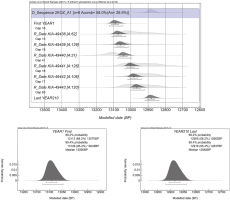
Despite a relatively large diversity of individual ring-width patterns incorporated in the site chronology 2KOZ_A1, the signature years are clearly marked (Fig. 6), which helped to cross-date 62 samples against this site master (Fig. 8). The distribution of germination and falling of trees indicate their successive growth with the exception of rare episodes when a higher number of trees germinated or fell. Such a collection of fallen trees within a short time interval could be noted at the end of the chronology period, ca 200–210 relative years, i.e. ca 12880 20 cal BP.
Cross-dating of more than 50% samples of the chronology was hindered by ring anomalies: narrow-ring zones (comprising from a few to more than 10 rings), partially missing rings and completely absent rings. Dendrochronological analyses revealed that unequivocal fitting of numerous samples (over 50 %) representing pine trees growing in extremely difficult conditions at the end of the Late-Glacial period is very difficult, practically impossible. This is due to short ring sequences, frequent disturbances in lower parts of the trunks as well as abundant missing rings.
The individual tree-ring patterns imply different agents of tree deaths. In some cases, the growth ceased completely after several years of growth reduction, which most probably indicates the impact of a multiannual climatic factor, e.g. higher precipitation or lower temperature. Tree-ring series without growth reduction prior to bark edge may indicate tree death by extreme climatic events, most probably strong winds and wind storms. Frequent occurrence of compression wood (reaction tissue that counteracts the forces changing normal position of trunk and branches; Schweingruber, 1996 and Zielski and Krąpiec, 2004) is a clear evidence of strong multiannual unidirectional winds. In some trees, compression wood formed for periods from several seasons to more than a decade. Extreme climatic events are also indicated by parallel deposition of long trunks (Fig. 2).
Fig 8
Dendrochronological relative dating of the subfossil wood sample from Koźmin based on the chronology 2KOZ_A1.
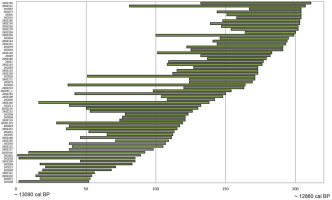
Fallen trunks were relatively quickly buried by flood sediments, which created conditions favourable for the excellent preservation of wood. Deterioration of climatic conditions at the turn of Allerød and Younger Drias led to dying out of the forest, and floods in a flat valley could relocate tree trunks for relatively short distances.
The wood encountered at the top of the organic series covered with flood sediments was very plausibly redeposited. This is indicated by traces and damages made by coarser material carried by the water on the wood surface all around the trunk perimeters, whereas the bottom parts of the trunks lying in peat in situ are devoid of such traces. Redeposition is also supported by the radiocarbon dating, which proves the occurrence of distinctly older wood in the same depositional horizon (Table 1). Among the dated (using the AMS technique) samples, significantly older are sample 2KOZ19 (ca. 13216–13095 cal BP, 1 s) and sample 2KOZ80 used for the testing of various techniques of chemical preparation of subfossil wood (average age: 13315-13221 cal BP, 1 s). Results of the dating of α-cellulosis from subfossil wood using the AMS technique are consequently 200–300 years older than the LSC dating of wood samples that underwent AAA preparation (Dzieduszyńska et al., 2014a; Krąpiec et al., 2018; and Michczyńska et al., 2018).
. Conclusion
Based on hitherto made radiocarbon dating, it can be postulated that the Koźmin wood grew within the interval of 13300–12850 cal BP (see Table 1). However, accurately defined chronology spans a period of ca. 13110–13070/12910–12860 cal BP (Fig. 7), i.e. the inter-Allerød oscillation (Gerzensee) (Dzieduszyńska, 2017). This is the period covered by the SWILM floating chronology (Kaiser et al., 2012), as well as the BINZ 1c and d chronologies (Reinig et al., 2018). Despite the lack of correlation between the chronology from the Koźmin site and the Alpine chronologies, this chronology should be a valuable source of data for future studies, e.g. analysis of stable isotopes, as well as important element enabling the construction of a Late-Glacial chronology for central Poland, in particular the area covered by mining activity of the JSC Lignite Mine (Adamów). This is particularly prospective, e.g. for the Kwiatków site, 4 km to the north of the Koźmin site, where remnants of the subfossil forest were identified (more than 250 large trunks), and very well-documented 2KWI_A3C chronology spanning 265 years was tele-connected with the Reichwalde chronology (Friedrich et al., 2001) and dated to a period of 13821–13557 cal. BP (Krąpiec et al., 2018). The hitherto obtained results of the dendrochronological studies in the Koło Basin, namely the chronologies of the Late Weichselian covering in total almost 500 years, show that systematic studies could potentially result in the construction of a chronology spanning ca. 1000 years, as in central Germany or in the fore-Alpine area (Friedrich et al., 2001, Kaiser et al., 2012, Reinig et al., 2018). This is important because these are sites situated far away to the east from the studied sites comprising well-preserved wood from the Late Glacial, which, in turn, should allow to analyse synchronicity of climatic changes in Europe.
